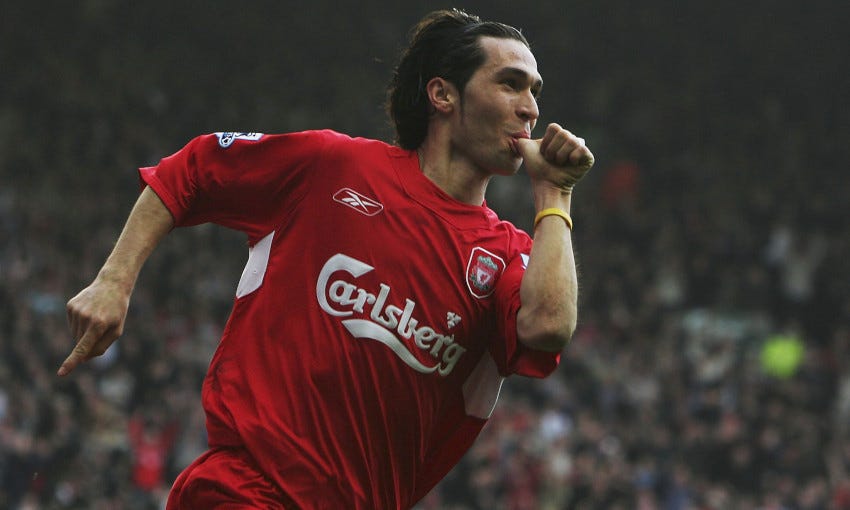30 Years, 30 Reds on the march to 19.
Take a walk down memory lane and reminisce about 30 Reds who didn't win the league. Cult players. Fallen heroes. Fan favourites. Here are thirty Reds we love.
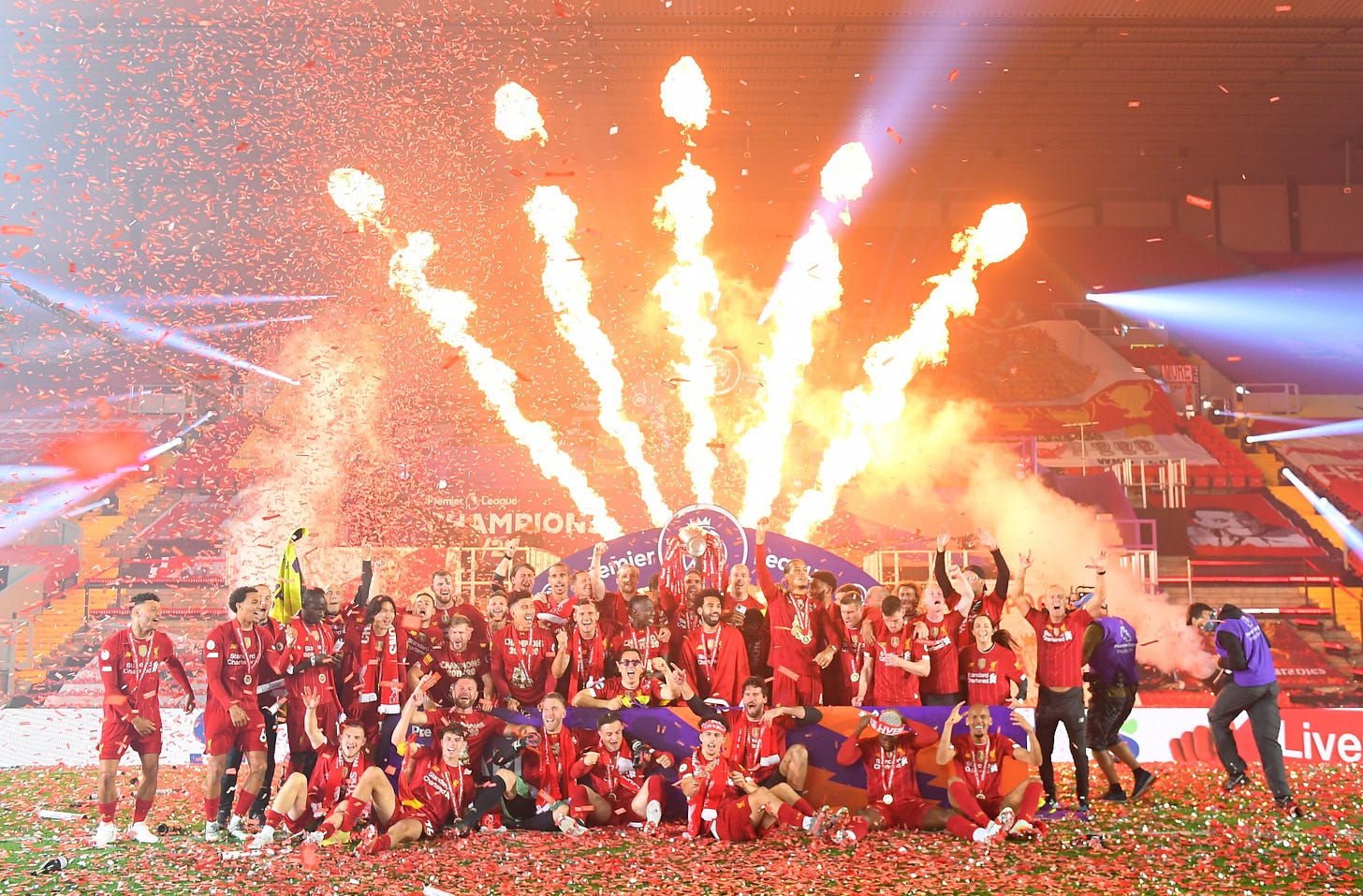
[EXTREMELY LONG ARTICLE WITH PLENTY OF VIDEOS AND PICTURES ALERT]
So… Liverpool FC have finally gone and done it. They’ve won the league title. The previous time Liverpool won the league title, I was about 6 months old. I can’t even begin to describe the last 5 years under Jurgen Klopp… it has been a treat in every sense.
We've witnessed some of the best football I've seen the club, or any team play, for that matter. It certainly didn't happen overnight. Jurgen Klopp has rebuilt a team that was totally broken by that failed title bid in 2013/14. But I really don’t subscribe to that “30 Years of Hurt” narrative that has been pushed in the wake of the title being won. We didn’t win the league… but we sure had fun along the way, including two Champions League triumphs. As the celebrations raged online in the wake of Chelsea beating Man City, many of us couldn’t help but wish some of our former players could have lifted the league too.
Plenty of beloved players have worn the red shirt during the thirty years, and we’ve loved them for various reasons. There are the ones who are easy to love: the world-class players, the game-winners. There are also the loyal servants, players you got so used to seeing play week in week out, you just grew old with them without really realising it. There are the oddballs, players who gave you a laugh. The youngsters we pinned all sorts of hope and expectations to, for various reasons. Then, there are heartbreakers: players you adored but left at some point in the most painful manner that you probably had to do some therapy for.
With that said, I’ve gotten a little help from my friends on LFC Twitter to pen some of their thoughts and stories on their favourite players from last thirty years. Let’s celebrate 30 players we’ve loved, for a myriad of different reasons.
Take a walk down memory the Fields of Anfield Road. Walk on.
Steve McManaman (1990 - 2000)
by @EJ_1892
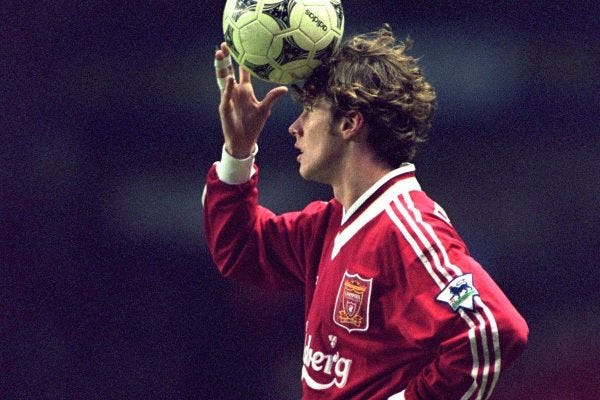
Of the bits and bobs of Liverpool merch I’ve accumulated over 30 odd years supporting Liverpool, few are as beloved as this Topps soccer card: Macca still a fresh-faced football sprite.
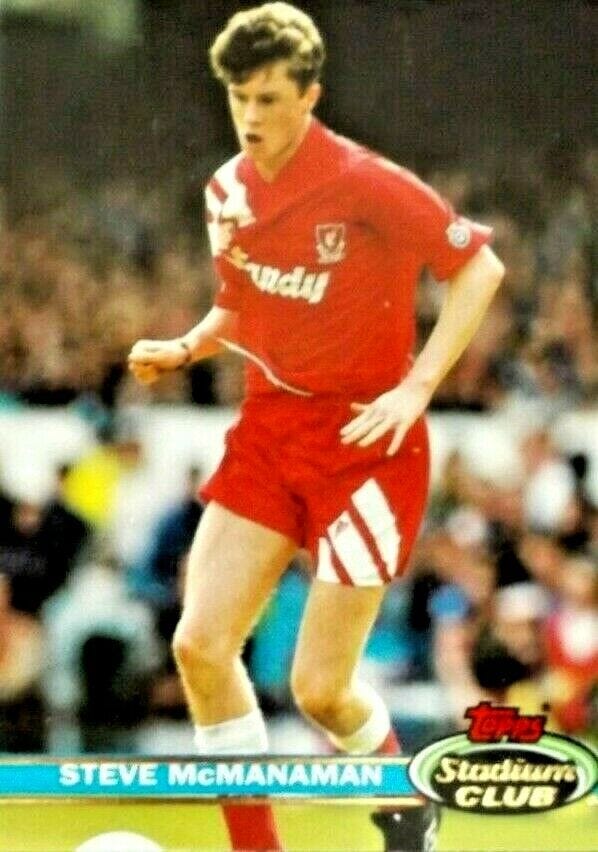
I remember the day I pulled it, not because I realized at the time how much I would fall in love with him, but because on the same day, a second pack yielded a John Barnes card. For a myriad of Liverpool supporters, Torres was the footballer that taught them to never love again; for an earlier generation, Macca decamping to Real Madrid in 1999 provided the same lesson.
After Souness was fired, the swashbuckling football Evans brought was a welcome reprieve, and at the centre of it all, Macca was given a free role to pull strings as a marauding and free-floating playmaker, rewarding Evans with two goals in the League Cup final win over Bolton (known as the McManaman final in some quarters) and 25 assists in the following season’s campaign. The Reds played beautiful football under Evans, spearheaded by Macca’s brilliance, and it was cruel they never won the title they were capable of.
For some, he will always be associated with the Spice Boys and the decline of Liverpool, but to do so is unfair to an ineffable talent that was one of the brightest stars England have ever produced and perhaps the greatest of his generation, evidenced not least by his success at Real Madrid and the high esteem their supporters still have for him.
In Soccer in the Sun and Shadow, Galeano distilled the essence of why many of us follow this stupid and profound game, writing: “Years have gone by and I’ve finally learned to accept myself for who I am: a beggar for good soccer. I go about the world, hand outstretched, and in the stadiums, I plead: ‘A pretty move, for the love of God.’ And when good soccer happens, I give thanks for the miracle and I don’t give a damn which team or country performs it.” Of course, those moments are all the sweeter when it is for your team, but perhaps no higher compliment and thanks can be paid to Macca than that I still watched his success at Real – a team that I loathe – and could not help but celebrate it.
My first trip to Anfield was in February 2014: the infamous 5-1. While much of that day is etched in my memory forever, perhaps the firmest memory was from hours prior. I nervously circled Anfield at around 9 a.m. and chain-smoked, waiting for pubs to open, and ran into Macca outside the ground (he was announcing for NBCSN that day). I stopped in my tracks, too dumbfounded to say anything and stared – reduced and transported once again to a wide-eyed teenager – eliciting a “cheers, mate” from him. I replied with a wave and a nod, wishing for a win on that same Topps card that was sitting in my wallet, a talisman owned at that point for 20 odd years and carried to Liverpool as though it might somehow help us finally bring home the honour that eluded us since 1990.
Stig Inge Bjørnebye (1992 - 2000)
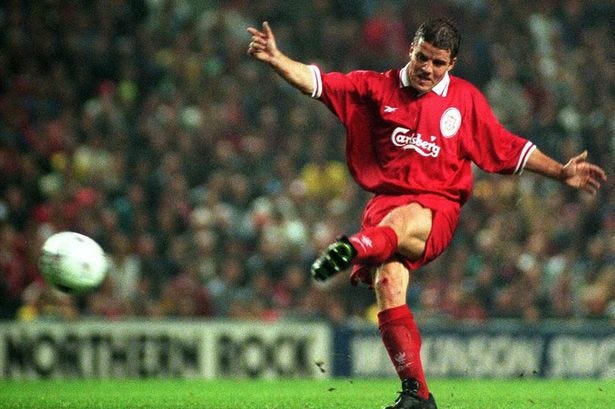
Bee-yawn-na-bee. Stig Inge Bjørnebye was a player I gravitated to as a kid simply because his name was a hoot. Signed by Graeme Souness after scoring the game-winning goal for Rosenborg against Lillestrøm SK in the Norwegian Cup final, Stig initially struggled to adapt to the league, even going back on loan to Rosenborg for one season in 1994. When he returned, Roy Evans was the manager in charge of the team. And as with most things associated with the Roy Evans era, things got really fun.
A no-nonsense fullback, the highlight of his game was seeing him bomb down the left flank using his exceptional long-range passing and cross to lay a ball sweetly for Robbie Fowler or Stan Collymore to tap in. His long passing was so good that it was a feature of the Norwegian National team. The rather tall team had a practical giant in winger Jostein Flo, and direct passes from Bjørnebye to Flo were so common, it was termed the “Flo-Pass”. What a name, what a peg, what a player.
Robbie Fowler (1993 - 2001)

God. A player created with the sole purpose to score goals in every possible way. And score goals he did. Left foot. Right foot. Inside the box. Outside the box. Headers. He did it all. Now watch Robbie Fowler destroy Arsenal in 4 mins with a hat trick. It never gets old.
For a good three to four year period, Robbie Fowler (together with McManaman) was the most exciting thing about Liverpool FC. Their ultra-attacking style of play infused the club and its fanbase with so much joy. It very much was the embodiment of youth just taking on the world without a nary of doubt or care in the world. Even to this day, when I see Robbie showing up to make an appearance in Legends games or even Soccer AM to smash their Top Bins segment, I can’t help but smile knowing somehow, someway, the ball’s gonna find the back of the net.
Jamie Carragher (1996 - 2013)
by @80couches
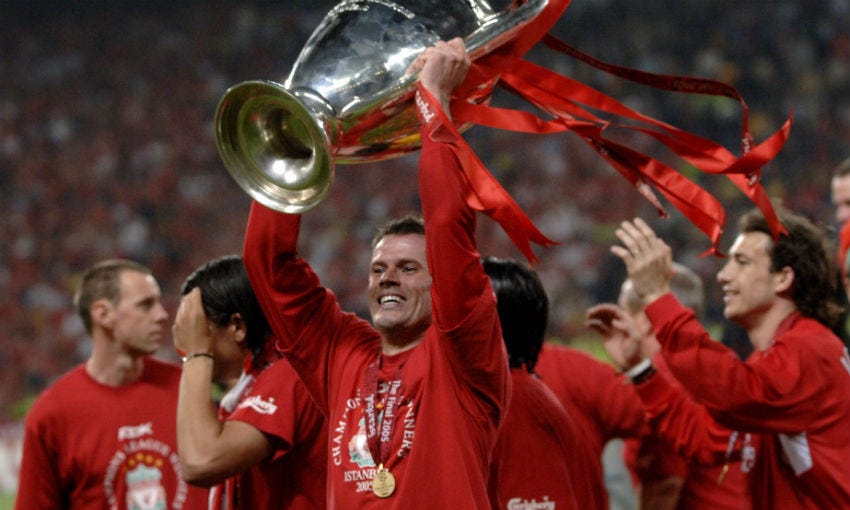
The mark of a truly great player is the ability to survive at a club as managers come and go. To this end, Jamie Carragher is one of the best. He made his debut under Roy Evans and ended his career under Brendan Rodgers, which is sort of mind-boggling in its own right. He racked up a total of 737 appearances, good for second-best in club history, and a Liverpool record of 150 Champions League appearances. An absolute mainstay. And he won a few things along the way: a European Cup, a UEFA Cup, two FA Cups, three League Cups, and two UEFA Super Cups. Of course, he didn’t win the Premier League, so he makes this list.
Although Steven Gerrard earned a lot of the fan and media plaudits during his captaincy, the other Scouser in the team—Carra—was just as much of a leader on and off the pitch. He was never the biggest, tallest, strongest, and certainly not the fastest, but his ability to read the game, match intelligence, and work rate made him one of the best English defenders in his prime. Being a Scouser at Liverpool is always an advantage, and Carra made the most of it; his tough-as-nails, no-nonsense demeanor suited the club and city down to the ground. His highlight reel will never be as extensive as Stevie G’s, but he was integral to the success the club earned in the 2000s. He started and ended his career as a Red, and it might be a long time before we see anyone approach the number of total and European appearances for this club. A truly special player and he deserves to be recognized.
Patrik Berger (1996 - 2003)
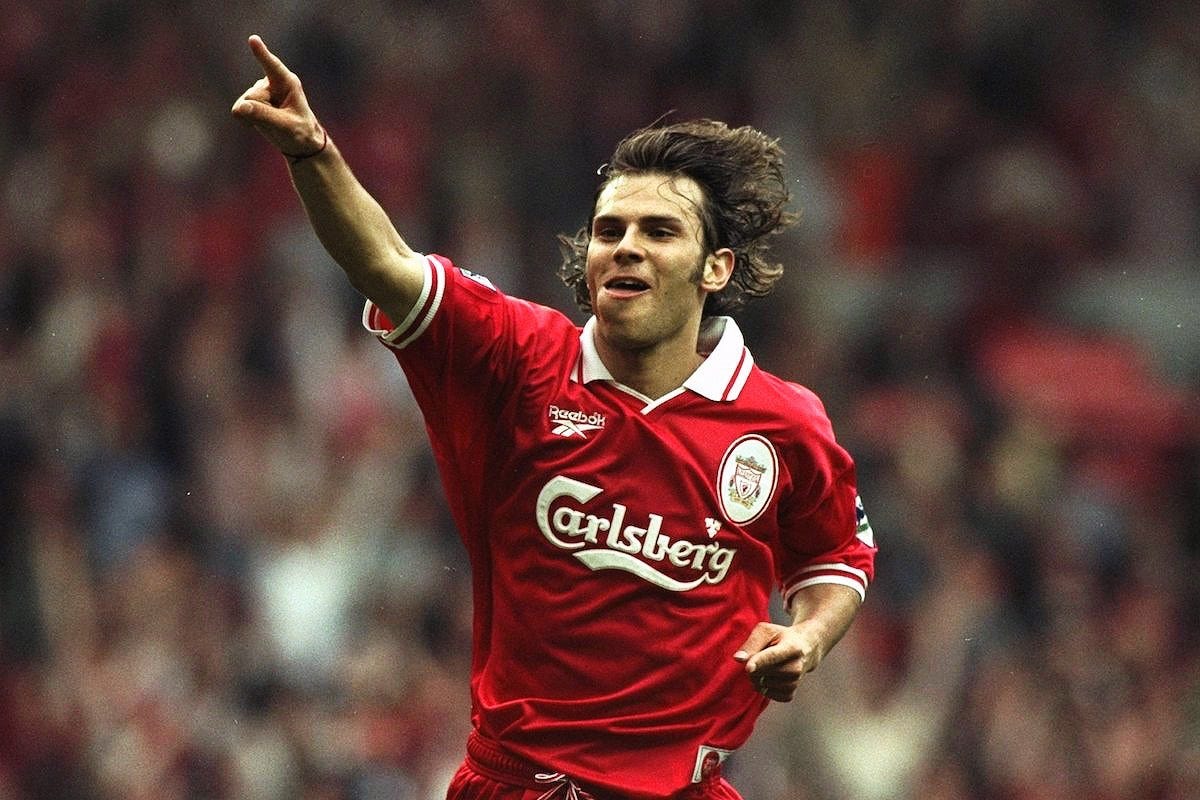
The summer of ‘96: the Czech Republic became the darling team of the Euros. In what was their first international tournament, the team stormed all the way to the Final, where they lost to eventual winners Germany (of course). Several team members landed big transfers to some of Europe’s finest clubs. Pavel Nedvěd went to Lazio. Our rivals Manchester United got Karel Poborský. We got Patrik Berger.
Patrik achieved plenty of success during his spell at the club, including a critical role in 2001 Treble (he supplied the pass for Michael Owen’s winning goal in the FA Cup Final.) Yet, he remains one of the club’s biggest “What If?” stories. Somewhat mismanaged and deployed all over the midfield under Roy Evans, Berger really blossomed under Gérard Houllier, receiving regular game-time under the French boss that had eluded him in his second season under Evans. Unfortunately, a string of recurring knee injuries would begin during this period that would ultimately cut short his Liverpool FC career.
A supremely elegant player, Berger also had a streak of brawn to his game. He could often be seen surging powerfully to the outside of the box (note: he scored a hat-trick against Chelsea in October 1997), where his piledriver of a left foot would send the ball screaming into the ball of the net. The memories may fade but there’s always YouTube. Patrik Berger bangers from outside the box forever.
Michael Owen (1996 - 2004)

We know. Thus begins the first of many cautionary tales on this list. We don’t really want to talk about it… but we will. Because *Thor voice* that’s what heroes do.
In a game where 22 players are on the pitch… it’s especially rare for anyone to be considered truly game-breaking. But that’s what Michael Owen was for Liverpool. You can’t tell the story of the modern striker without mentioning Michael Owen. Just like the Brazilian Ronaldo, Owen was an important milestone evolution of strikers who added so much more to the position. Suddenly, strikers weren’t just waiting around in the box for the ball to come to them anymore. Possessing incredible speed, agility, and technical skills, Owen was able to carry the ball from deep, facilitate link-up, or just simply run and make players look stupid for trying to even keep up with him.
The peak of his Liverpool career would be the 2000-2001 Treble winning season, where Owen also notched the Ballon D’or. The FA Cup Final would come to be known as the “Michael Owen Final”… with good reason. If not for some heroic defending and missed calls, a truly great Arsenal team should have put away this Liverpool side comfortably. But the lads hung around… and then Michael Owen happened. Despite him donning the United shirt and his inane commentary and punditry work, I can’t help but still feel massively privileged to have seen a truly world-class player at the peak of his powers play for our club.
Steven Gerrard (1998 - 2015)
by @EJ_1892
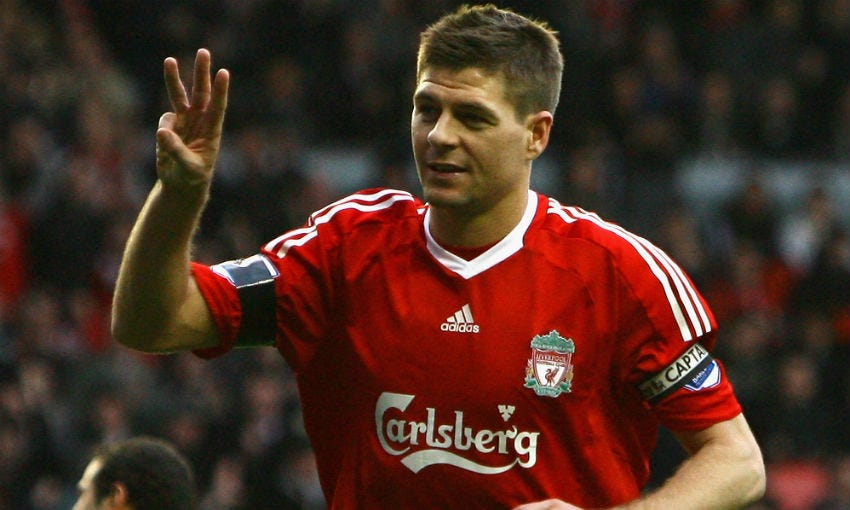
There are not many things one can write about Steven George Gerrard that have not been written. Print is a vast space, and Stevie has been deified in so many spaces, places, minds, and hearts it’s more than difficult to find something to say that doesn’t feel trite.
Think about joining that club at 8 with all the other fresh-faced young boys. Liverpool were top of the world. Then Hillsborough, which claimed your cousin’s life; but playing, always playing. Then Kenny left; but playing, always playing. Then LFC don’t win a title; but playing, always playing. So you can wear the Red. So you can play for Liverpool Football Club. Then LFC still don’t win the title; but playing, always playing. So that one day you can captain Liverpool Football Club. And the drought goes on; but playing, always playing. So you can win the title for Liverpool Football Club.
And as you’re playing, always playing, folks are starting to take notice. Folks are wondering: can this gangly teenager stop these Manc bastards in their tracks and bring the titles back to our city. You look pretty good, but you’re not the undisputed best. Some people think other players might better lead the team.
You’re 18 years 182 days and you finally debut for the first team (against, of course, the team Kenny coached to a championship not four years prior). Folks think you look nervous. Like you might not have it. Like you might not be good enough to play for = Liverpool Football Club. The club for whom you have been playing since 8. The club for whom your cousin died. The club that still has not won a title since you were 10; back when they were on top of the world.
You keep playing and playing. It’s 2001 and the Mancs are marching to knock us off our perch.
You’ve already made the first team, but now you are named Captain. Captain of Liverpool Football Club; the club for which you’ve played since 8; the club that now has gone 13 years without a title. You know it has been too long. You hear it from your family; friends; neighbours; and folks on the street. All the time. You hear it all the time. You can’t leave your house without hearing it, without strangers accosting you on the street; you are their avatar.
Because you have kept playing and playing, you have injuries: four separate groin surgeries; back problems. You keep playing and playing, and Liverpool Football Club win the treble under Houllier. But not the league. You still have not won the league.
The stress of managing LFC nearly kills Houllier via heart attack. You finish second. Houllier is fired. Rafa Benitez is recruited from Valencia, which he guided to an improbable La Liga title. You single-handedly drag LFC to a Champions League title. You single-handedly drag Liverpool to an FA Cup win. But it’s not the league; the league still awaits.
Players come and go, you keep playing. A Spanish sensation – El Matador, El Nino – is brought in. You and he have a telepathic connection. You make a Champions League semi-final a year after making the final for a second time, but this time Chelsea finally advance. A year later you lose only two games all season. You still finish second. It’s the second time you’ve finished second. Rafa is unceremoniously fired after years of clashing with the owners. The club hires Roy Hodgson.
The club is on the verge of administration. The club has sold off elite players for bit parts in naked asset stripping. The club is bought by some different Americans that know nothing about football. You keep playing.
The club is in a relegation battle; you wonder if maybe you should have gone to Chelsea all those years ago when Mourinho was walking the league wanted no player on Earth more than you. You keep playing. In red; in front of the Kop; in front of your hometown supporters. You miss a cheeky pen on purpose. Hodgson is fired. Your hero, Kenny Dalglish takes over to stop the rot. El Nino leaves.
Despite domestic cup success, Dalglish is fired. Including Thompson, Brendan Rodgers will be the sixth manager you’ve played under. Liverpool manage to strike gold with Luis Suarez, Phil Coutinho, and Daniel Sturridge. Your body is breaking down. You keep playing, you can barely walk some days, you receive injection after injection to make sure you can be on the pitch, in red, Liverpool’s red.
On April 13, 2014, you beat the most recent money-doped football club, 3-2. You’re top of the league, four matches from glory. It’s been 15 years since you made your debut, 24 since Liverpool last won a title. Another 3-2 victory over a plucky, relegation-threatened Norwich. Three games from relief. You have spent the entirety of your life working towards this moment alone.
Mourinho, the manager that nearly tempted you away ten years ago, is back at Chelsea, at Anfield, and anything but a loss will do. You get another epidural for your back so that you can make it through another match because what you do is keep playing. Mourinho has come to Mourinho: sit back and perhaps nick something on the break of a set-piece. Sakho plays you a routine pass. You are in the discussion of the greatest footballer of your generation; Zidane has called you the best midfielder in the world. Liverpool are now down 1-nil.
You have dragged this football club through hell. Over the years you’ve been forced to play with players not fit to lick your boots. You are the fucking club. You have performed miracle after miracle countless times on the biggest stage. You have scored every imaginable goal from every imaginable angle over the years, repeatedly appearing to defy physics. The crowd, your crowd, are nervous. There is no final miracle goal. It’s now two-nil. If City win their games in hand it will come down to goal difference.
You’re up 3 nil, it could easily be more. It’s improbable but not impossible that Liverpool could still do the thing. Easy chances to make it four are spurned. Time for more is running out. It’s 3-3. No one is quite clear what the fuck just happened. Luis is in bits. You swallow it down. Put on that same stoic face.
Luis leaves. You keep playing. Liverpool are unceremoniously dumped out of the Champions League at the group stages. You keep playing. Liverpool have their worst start to a league campaign in 50 years. You keep playing. Liverpool are listless and disjointed despite putting together a run of 12 unbeaten to right the ship. Liverpool lose to Villa and Chelsea in the semifinals of the domestic cups; you finish sixth coincidentally the same number of goals Stoke score against Liverpool the final match of the campaign, your final match as a Red.
As I write this, Liverpool are going to kick off against Chelsea in about thirty minutes; we are Premier League champions. There will be a trophy ceremony after the match and Kenny is going to hand the trophy to Jordan Henderson, whose red card against City in the 3-2 win back in April 2014 and subsequent ban, may well have been the primary reason the title was lost that year. It is hard not to feel a little rueful that Steven will not be in a kit on that same podium, and it’s fair to believe there are few things crueller in the history of our club than Gerrard thrice being denied the title.
Still, very little brought me as much joy as watching him grow from that gangly kid winging it at right back into the best footballer on the planet. I’m not sure that any footballer will, ever again.
Sami Hyypiä (1999 - 2009)
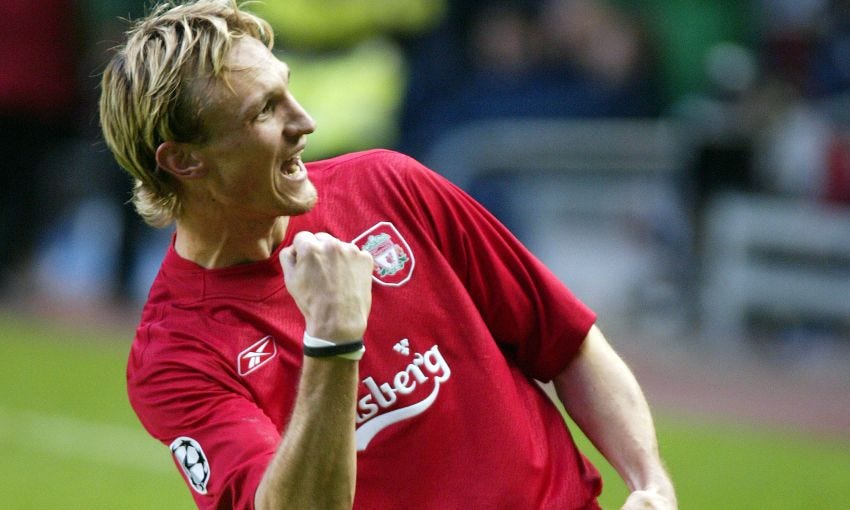
Signed off a recommendation by a TV cameraman to former chief executive Peter Robinson, Sami Hyypiä wasn’t expected to be anything beyond a fringe squad player. Once he stepped onto the pitch for his boyhood club, everything changed. Instantly forming a great partnership with fellow newcomer Stéphane Henchoz, Sami would entrench himself in the team as the rock of the defence for the next decade. Under Rafa Benitez, Jamie Carragher would shift to centre-back, and that combination would form a recipe that would help the club win the Champions League in 2005.
Luis Garcia’s cracking strike against Juventus is what most people think about when we bring up Liverpool vs Juventus from 2005, but this striker’s finish from Sami brings me just as much joy too.
Or this towering header against Arsenal in the Champions League. Sami Hyypiä has been many things to Liverpool: Fan. Bargain. Captain. Defensive lynchpin. In the final years of his stint here, he was a mentor to the other defenders coming on up. Through it all, he’s always been Sami Hyypiä, Mr Dependable.
Djimi Traoré (1999 - 2006)
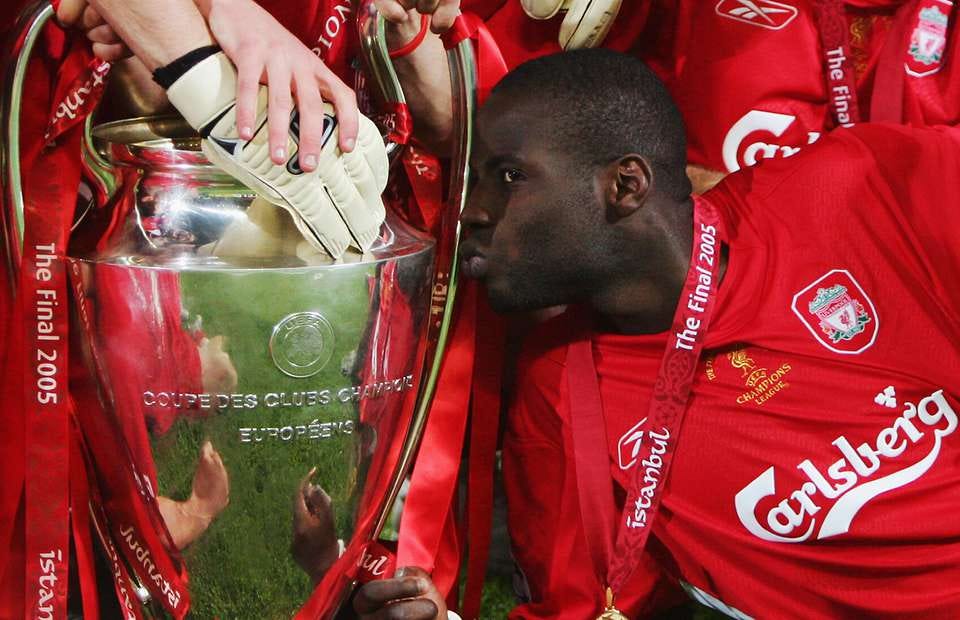
Djimi Traoré: Champions League winner. It’s a phrase often used as a punchline to describe how much of a freak result the 2005 Champions League triumph at Istanbul really is. An offensively-limited player who was prone to errors and often found wanting positionally, Traoré was already on the outs in Gérard Houllier’s last year in charge. He spent the entire frozen out in the reserve team and was even on the verge of a move to Everton at the transfer deadline. However, he stayed a Red and when Rafa Benítez took over, he got some game time.
He continued to make mistakes: an attempted turn and drag back in the box in the FA Cup was the cause of an own goal that knocked LFC out against lower-tier Burnley. Even in the Champions League final, he was the guy who conceded the free-kick that led to the Paolo Maldini’s goal in the first minute. However, Djimi stayed on the pitch and did this.
When I think of Djimi Traoré, it’s about perseverance and good things happening to good people. Djimi Traoré Champions League winner… none of the jokes and mockery can take that achievement away from my guy. That’s forever.
Gary McAllister (2000 - 2002)
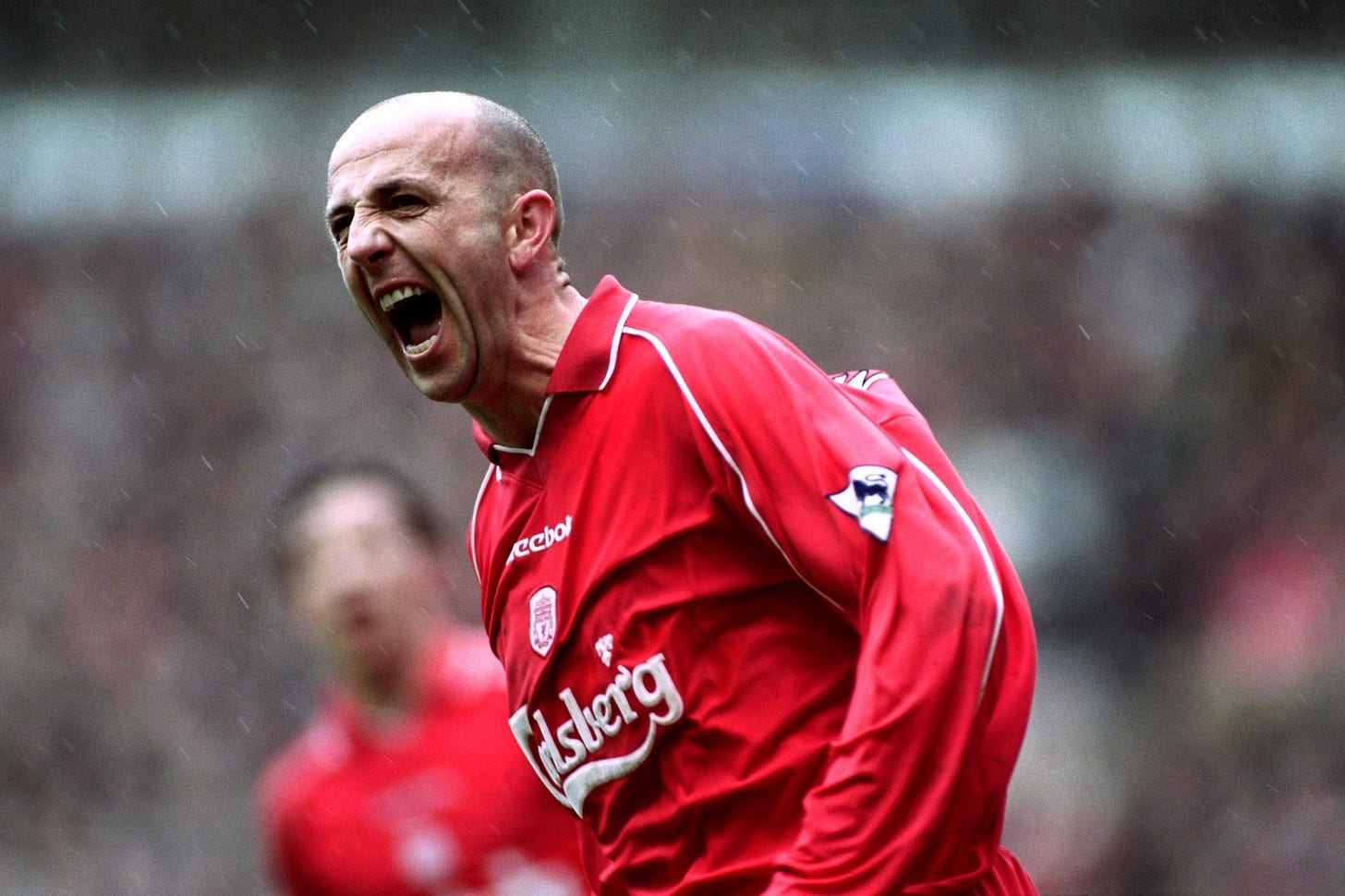
Gary McAllister moved to the club on 1 July 2000 at the ripe old age of 35 on a free transfer. It would prove to be one of the best pieces of business they would ever conduct. Now, I had been familiar with Gary playing for Coventry City growing up… but even I had to go “Who is this old man and how is he doing this?” when he played for Liverpool.
McAllister had a knack for popping up with key goals or assists in the most pivotal of moments during the 2000-2001 Treble season. A penalty against Barcelona in the UEFA Cup semi-final to get us to the final. Crucial goals against Coventry and Bradford City to help us secure European qualification again. Ice in his veins to score the opening penalty in the shootout against Birmingham City in the League Cup final. A man of the match performance against Alavés in the UEFA Cup final, where he had three-goal involvements, and a goal. It was his deflected free-kick that won the game for Liverpool in extra-time (Golden Goal was a thing then).
And of course, there’s this. A 94th-minute free-kick winner against our local rivals.
One of the most inspirational old man signings of all time, Gary McAllister remains beloved around Liverpool FC, with good reason.
John Arne Riise (2001 - 2008)
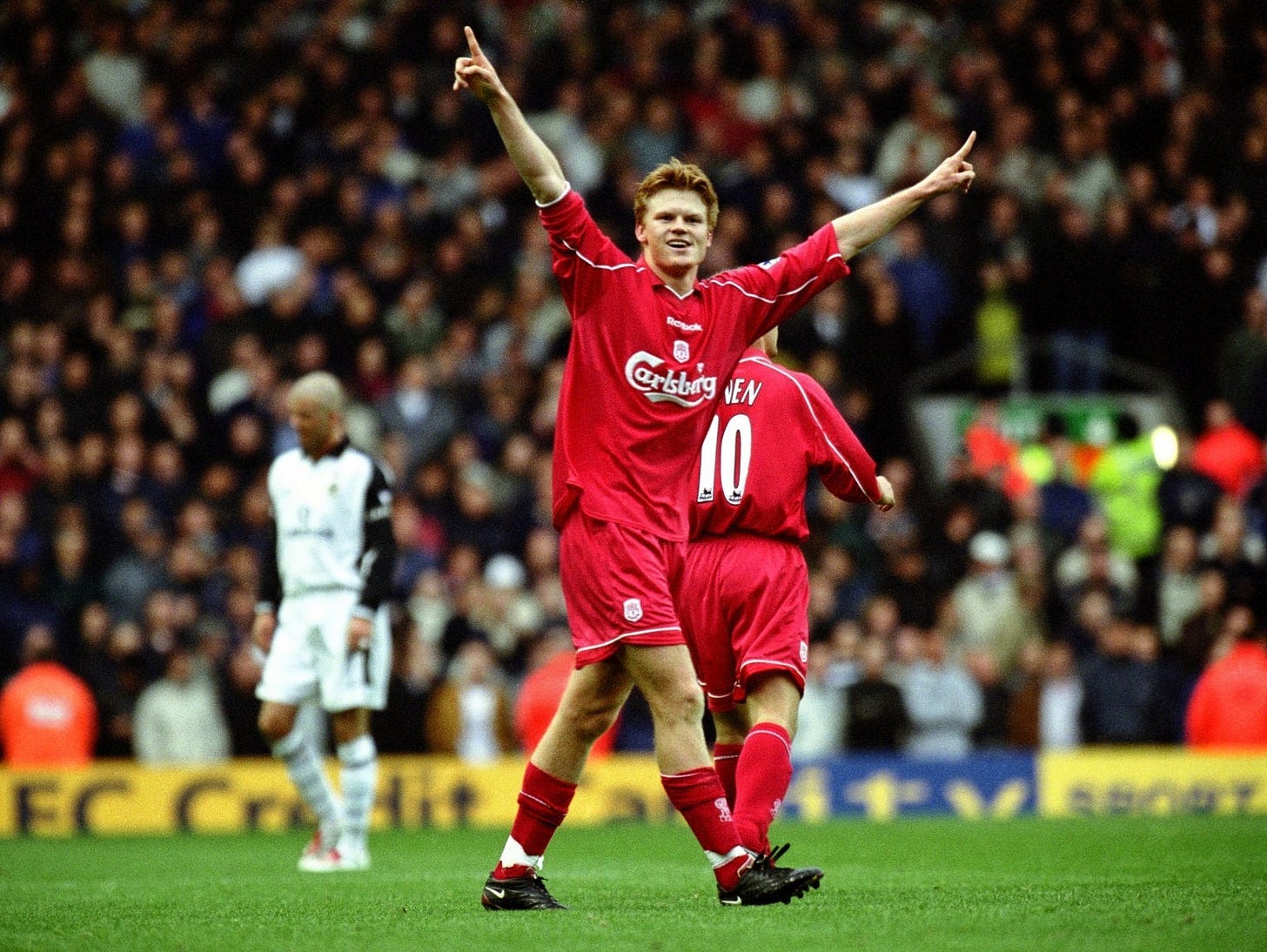
There’s something about Liverpool FC and Norwegian left-backs, isn’t it? Signed by Gérard Houllier, Riise would feature regularly, but would really begin cementing his place when Rafa took over. A marauding left-back, who also doubled up at left midfield at times, Riise was known for his stamina and one of the most powerful shots in the game. *Banger compilation time*
When I think of Riise, my mind immediately goes to two things:
On 18 February 2006, Liverpool defeated rivals Manchester United in 1–0 defeat at Anfield in the FA Cup. Manchester United forward attempt to block a John Arne Riise freekick/shot, and broke his leg and dislocated his ankle in one of the worst injuries I’ve seen. His career would never be the same. It’s still absurd that a shot could do that to another human being. I’m wincing at the very thought of it.
His bizarre row with Craig Bellamy before a Champions League Round of 16 match with Barcelona at the Nou Camp. Riise had apparently refused to sing karaoke, so Bellamy snuck into his room and attacked him with a golf club. Ironically, they would both score in the game, with Bellamy providing the assist. Bellamy celebrated his goal with a golf club swing celebration.
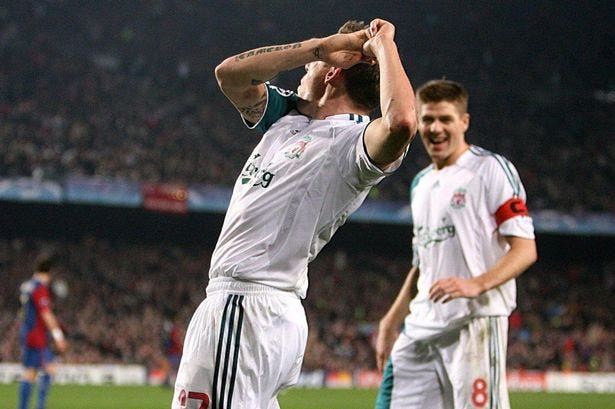
We would come to find out years later that Riise didn’t appreciate that gesture at all. What a strange, strange night and series of events.
Florent Sinama Pongolle (2003 - 2006)
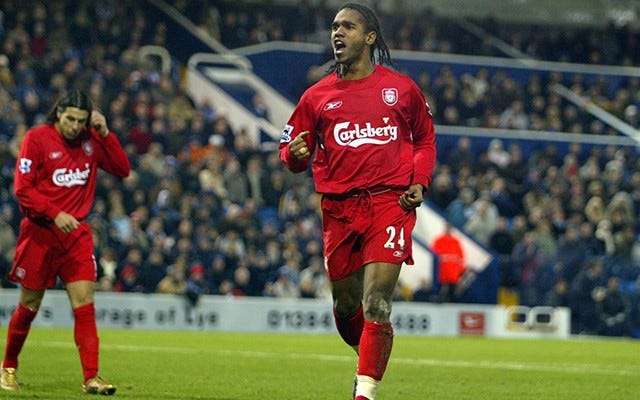
This slot goes to Florent, but it’s really about him, Anthony Le Tallec, and Bruno “the New Zidane” Cheyrou collectively, the French New Wave of youngsters that should have come in and changed Liverpool forever. (Special shout out to Neil Mellor, who became a top goalscorer and perennial Ballon D’or candidate in just about every game of Championship Manager 4 I played.)
After a series of spectacular performances together with his cousin Anthony Le Tallec at the UEFA European Under-16 Championship and the FIFA Under-17 World Championships, the two wonder kids were signed by Liverpool. Florent was 16 then. He won the Golden Ball at the latter competition, with Anthony winning the Silver Ball. The world was their oyster. Both kids would stay with Le Harve for another two years before making their way to Merseyside. Now, this was really before we had obsessive nerds compiling youth game reports and tracking progress online. I read about these two signings, heard nothing and just hoped for the best. (The only youth development signing to ever turn out well this way was Raheem Sterling, and even then… we had a little bit more online reports then.) When they finally arrived… nothing happened. Both players failed to stick at Liverpool and were shipped out quietly in the middle of Rafa’s tenure.
Florent did do slightly better than his cousin, coming off the bench to equalise against Olympiacos in a critical tie on the march to Istanbul. He was a player typical of that era of Liverpool. Wild unabashed hope, crazy expectations, with a bag of mixed results. It’s the hope that kills you but it’s also the very thing that keeps you coming back every time a new season comes around.
Harry Kewell (2003 - 2008)
The Boy From Smithfield by @Neboneid
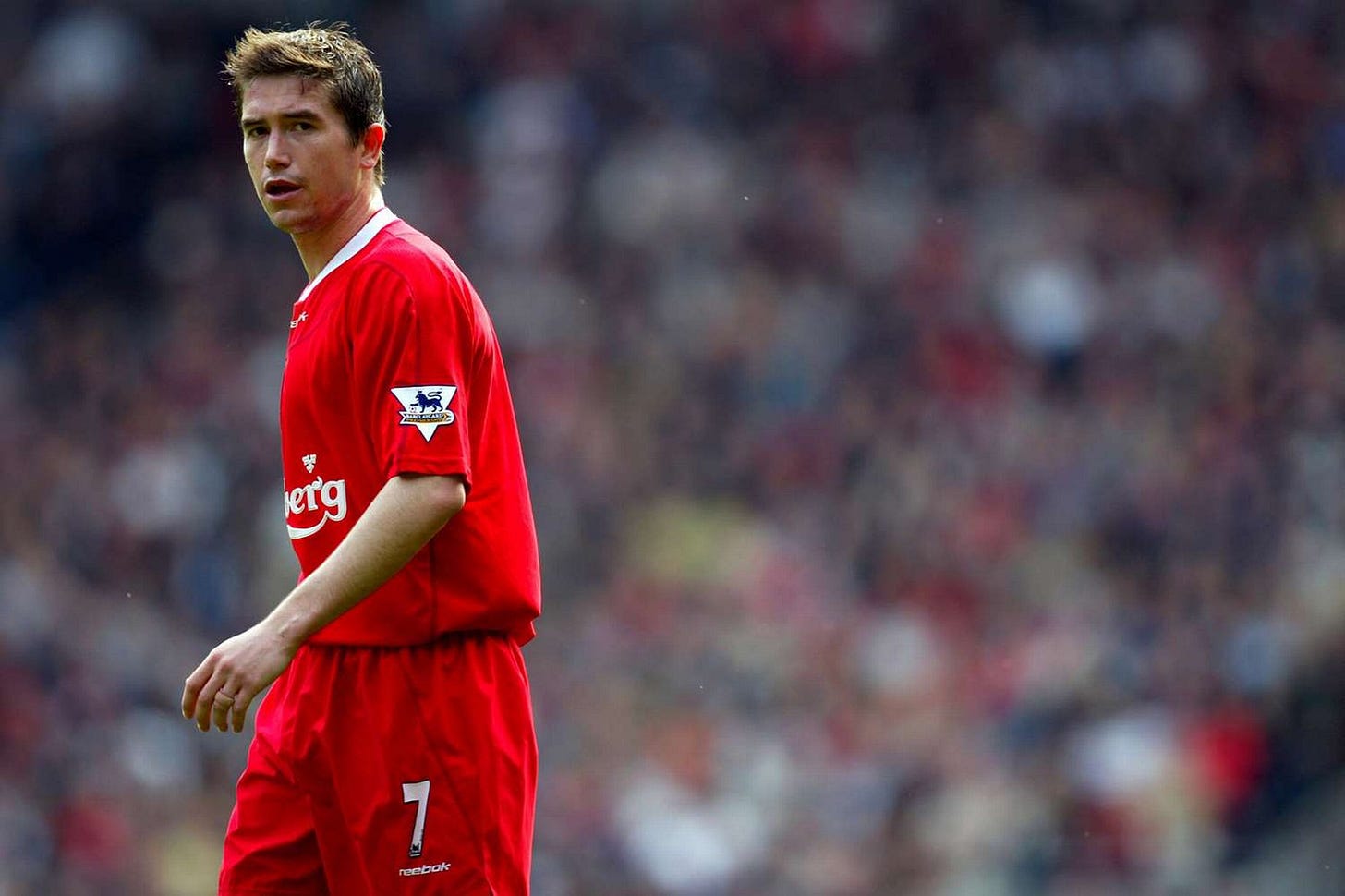
There was a boy in Smithfield, in what at the time, was the outskirts of Sydney. His dad came to Australia and settled in an old battered working-class suburb. His son would learn to kick a ball, first in his backyard and then in the local park, before being able to play for some of the biggest clubs in the area as a child.
He'd learn to love Liverpool FC and during his formative years, the club would go on to win nearly everything possible. Being thousands of miles away, in a time before the internet, before satellite TV, following his club of choice would be difficult, so the little boy would decide that one day he would just play for them instead.
That boy would grow up to become the greatest footballer Australia had ever produced and he along with countless others from his generation would all come from this one, rough, working-class, immigrant suburb in Western Sydney.
Harry Kewell, would eventually go down as a much-maligned player for Liverpool FC, he'd leave with a Champions League medal and a severely broken body by the time his tenure at Liverpool FC was up. He was nevertheless, our hero. He was a symbol of how big and how great Liverpool FC could be. Thousands of miles and yet at the same time in my very backyard.
The connection between the player, club, and my city, forever forged in a Champions League win, but he'd join a long line of players that just couldn't get that 19th title. 30 years’ worth of players have come and gone and yet none could do what Klopp's squad was able to achieve.
But nothing would change the fact that Kewell was my generation's gateway into Liverpool FC and for that, I am grateful.
Thanks for the memories, Harry, number 19, is as much for you as it is for any of us.
YNWA.
Xabi Alonso (2004 - 2009)
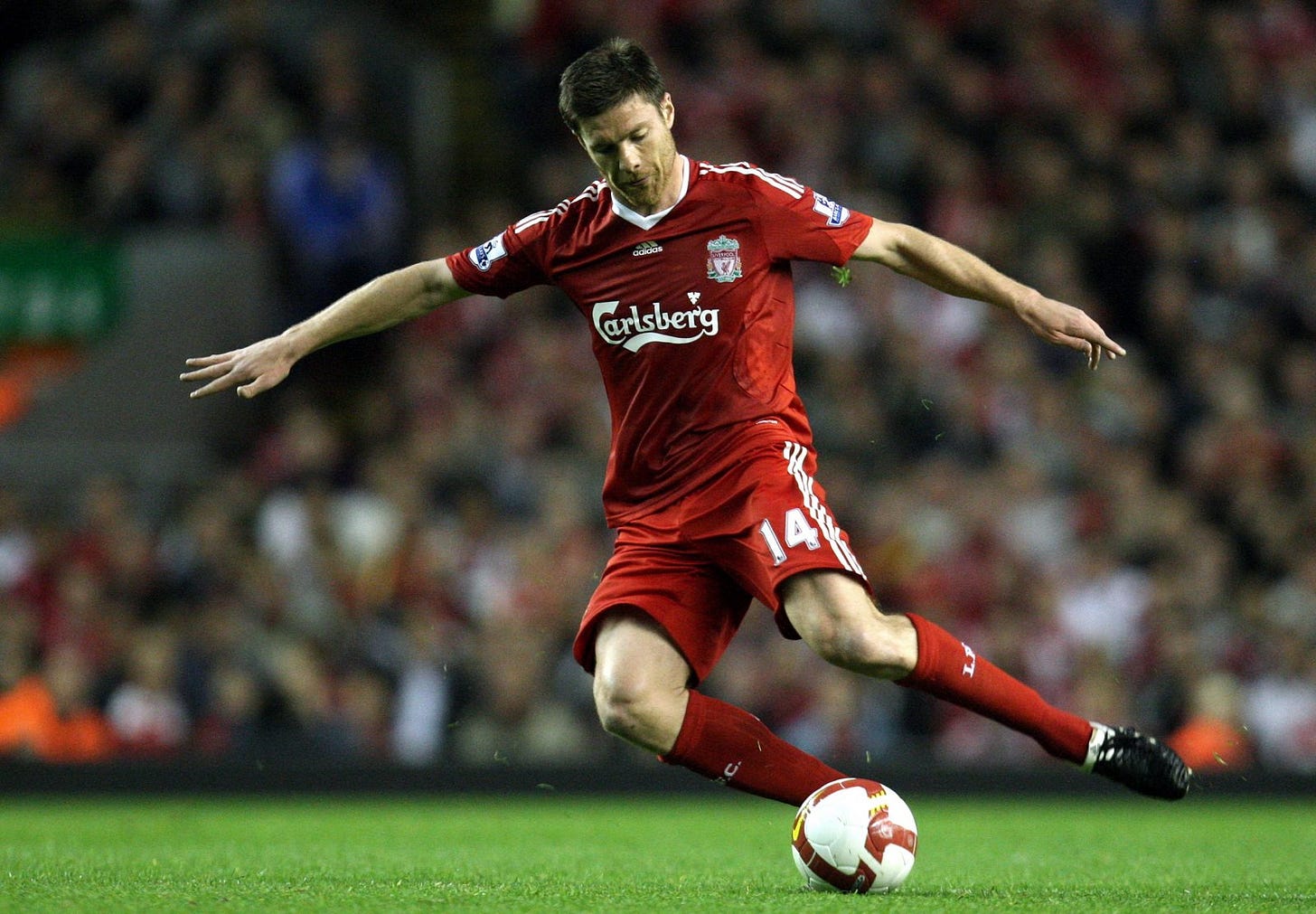
From the moment he stepped onto the pitch for Liverpool, Xabi Alonso was class. Alonso was the first foundational piece of the mid-2000s Liverpool squads that could boast “the best midfield in the world”. Those teams would prove to be a consistent problem in Europe for other clubs.
A remarkably consistent player, Alonso was a prototypical deep-lying playmaker, using his exceptional vision and peerless technique to send gorgeous looping passes up the pitch, switching the attack quickly from one side of the pitch to the other to catch the opponent off guard. A truly generational passer, Alonso was the quarterback in the centre of the pitch for Liverpool, a metronomic regista who kept the ball moving.
His presence freed up Steven Gerrard to fulfil his destiny of bombing up the pitch to score goals. A wonderful striker of the ball, Alonso also took set-pieces and had a powerful shot from distance. He is, remarkably, one of the few players in recent memory to have scored from inside his own half on multiple occasions.
Defensively, Xabi learned to use his height to his advantage. Using his intelligence and reading of the game, Alonso would often break up attacks and quickly spray the ball up for a quick LFC counter. He wasn’t afraid of fouling or kicking someone if needed, and that trait would eventually be taken to the next level when he moved on to Real Madrid. Playing under our nemesis José Mourinho, Alonso evolved into a true brick shithouse, a lynchpin that could stop attackers, while also springing one of Europe’s most speedy counter-attacking units in a blink of an eye.
Above all, Xabi Alonso was a terrific person. In his first season, Alonso displayed his dedication to the game and the badge, playing a full 90 minutes against Juventus in a second-leg Champions League despite just coming back from a broken ankle himself, partly because Steven Gerrard was suspended. Even after leaving the club, he’s remained a fan of the club, showing up to support the club and raising his kids as Liverpool fans. He famously irked Rafa Benitez by choosing to miss a game against Inter Milan, instead opting to stay by his wife’s side while she gave birth. Who knows if that played a part in Rafa Benitez's strange failed overtures in 2008 to replace Alonso with Gareth Barry. One of the first mainstays of those mid-2000 teams to leave, Xabi Alonso was never adequately replaced and the team missed his presence on the pitch for the next half-decade to come.
"Luis García, he drinks Sangria/he came from Barça to bring us joy!/He's five-foot seven, he's football heaven/So please don't take our Luis away!"
A polarising player if there was one. It could be argued your outlook on life could be measured by your appreciation of Luis García. While he was infamously frustrating for a sizable number of the fanbase, I loved just about everything Luis did. A true WILDCARD, it seemed like everything Luis García did had to be over-the-top and spectacular.
The ghost goal. The volley against Juventus. A header into the top corner despite being the smallest guy on the pitch. Luis García was magic. Luis García was imagination. Luis García was all about proving that impossible was in fact, possible.
Momo Sissoko (2005 - 2008)
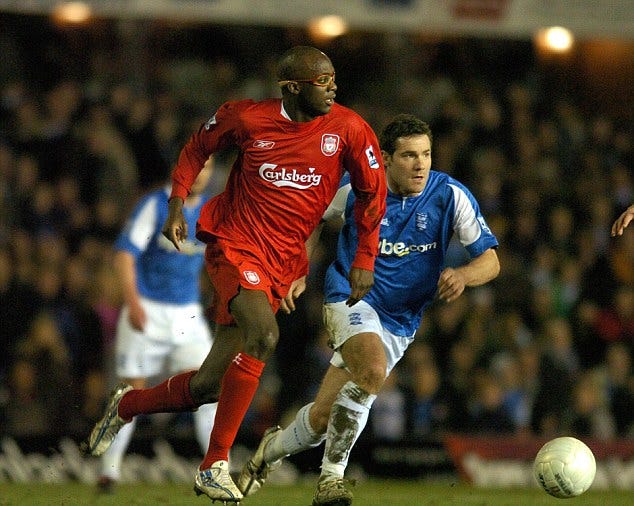
One of the most interesting players to put on a Liverpool shirt, Momo Sissoko really seemed like he couldn’t pass or shoot the ball… at all when he first joined. A physically gifted combative defensive midfielder, the gangly-limbed Mali international earned comparisons to Patrick Viera for his tenacity. He only scored one goal… just listen to the commentator’s surprise on this one.
A tireless destroyer in the middle of the park, Momo often amused me with what seemed like a free pass to kick opponents and never yet pick up a card for it. (It’s so much more fun when you’re not on the receiving end, isn’t it?) He would eventually be replaced by someone arguably better at the things he was the best at in Javier Mascherano, but Momo remains a memorable part of those “Best midfield in the world” teams. Plus, he wore Horace Grant goggles. Those are always really cool.
Daniel Agger (2006 - 2014)
by @Geo_Gabe
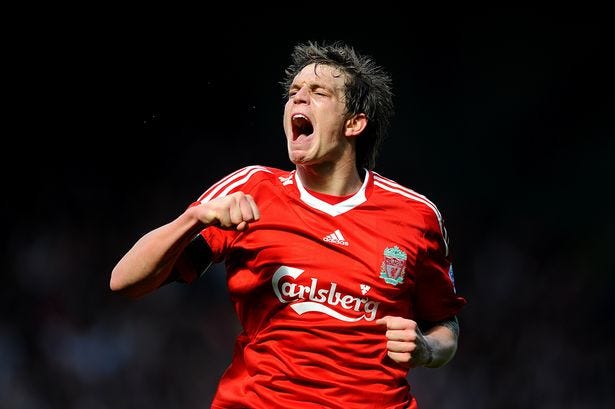
Over the annals of time, there have been plenty of players from the local region who have played for Liverpool. Few, if any, however, more embraced the ethos of the club more the Great Dane, Daniel Agger. When the likes of Barcelona came sniffing around, Agger responded by getting YNWA tattooed across his knuckles for all to see (he later followed that up with a Liverbird on his hand as well). He was Liverpool, through and through. When Fernando Torres left for Chelsea, Agger was livid.
Agger conveyed his opinion in person with a perfectly legal forearm to the throatal region of Torres (it’s legal if no foul is called, right?) the first time they played across from one another.
Beyond embracing the club ethos like few others, he was the perfect model of the modern centre-half. I’ll never forget the way the towering defender would survey the field while on the dribble before hitting a beautifully weighted through ball or a rocket of a shot with his left. While wonderfully skilled, he was never afraid to get stuck in with his fair share of hard tackles. If not for injuries, he would have been listed with the world's best.
Dirk Kuyt (2006 - 2012)
by @mattiecamp

Who could ever forget Luis Suarez's iconic 2011 goals against Man United, scything through every defender to score from an impossible angle, and bending a free-kick under Van Der Saar? Except it wasn't a Suarez brace that day, it was a Dirk Kuyt hat trick, by actually putting the ball in the back of the net from those moments of Uruguayan brilliance and a further moment of a Mancunian brain fart. It was a performance that summarised Kuyt's six-year Liverpool career - contributing everything the club needed from him, doing the hardest work even if the spotlight shone elsewhere on the pitch.
On the day I write this, Dirk Kuyt turns 40, and I would back him to put the boots on for Liverpool again tomorrow and probably score. The term "engine room" was probably used to describe players before Dirk but I can't conceive of a player more befitting the term. Of all the players who dragged us through seasons of drudgery, I feel like Dirk Kuyt probably deserved the payoff of a league title win most. He scored the late goal of resistance in the 2007 Champions League final and refused to admit defeat. Slogging through the decline of Rafa, the Hodgepocalypse, and the return of Kenny, he led the line with no complaints and did the job asked of him.
Dirk lived our culture; he spoke Scouse, he kept his modest attitude, he loved the fans and the red shirt. He soaked up the city like a sponge and carries us around in his heart to this day. His spirit will be as much on that stage when Jordan Henderson lifts the Premier League trophy as much as anyone.
Fernando Torres (2007 - 2011)
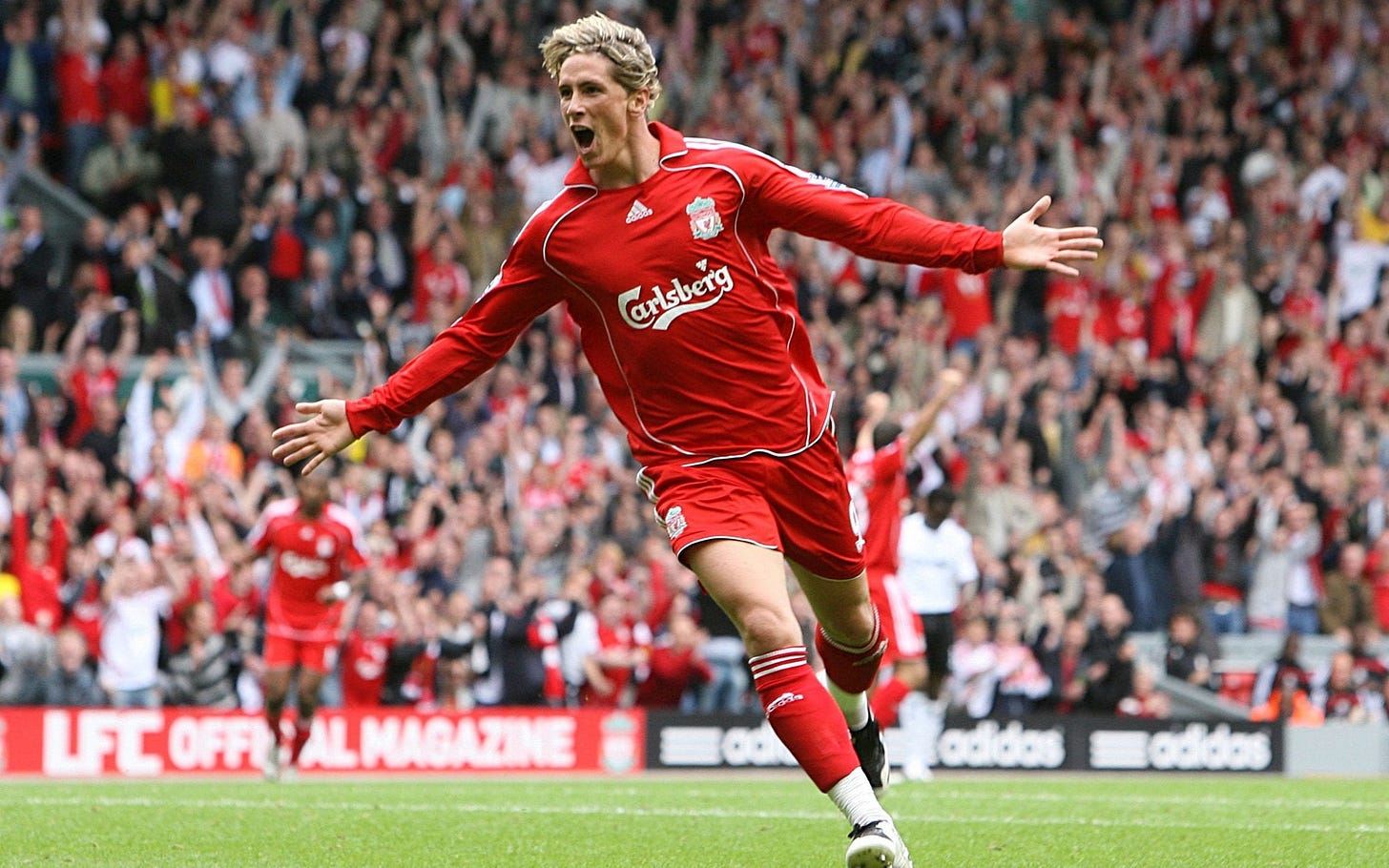
Having been spoilt for choice of top marksmen throughout their history, Fernando Torres’ arrival at Anfield was the end of a period where Liverpool FC had no real world-class striker. Since Michael Owen’s departure, the frontline had been led by decent talent in Djibril Cissé, Milan Barros, and Fernando Morrientes to middling returns. The expectations were high. The fact that El Nino had an armband with the words “We’ll Never Walk Alone” scribbled underneath it only served to heighten the fans’ hype for Fernando Torres’ eventual arrival at Anfield.
Already one of Europe’s top young strikers at Atletico Madrid, Torres became something else at Anfield. Perhaps buoyed by the presence of top-class creators like Gerrard and Alonso, Torres instantly became one of the most feared strikers in the league. Blessed with electric pace and great technical ability, El Nino was able to combine those traits with his penchant for the spectacular. In his first couple of seasons, it seemed like Torres was able to put the ball into the top corner from near-impossible angles with ease. Hardworking as well, he didn’t shy away from defensive work and often pressed defenders into mistakes. Torres was able to also drop deeper to link up and create, something that worked to devastating fashion with Steven Gerrard as a second striker.
It all seemed like a blur. A remarkable haul of 81 goals in 142 games. We loved the electricity in the air when he got on the ball, holding our breaths in the expectation that something remarkable was about to occur. We loved his propensity for scoring against Chelsea. We adored his constant torment and embarrassment of Nemanja Vidic, one of the best centrebacks in the league. 3 and a half short seasons of magic was cut short when Torres left Liverpool for Chelsea (not the first on this list). If anything, this was the first sign of the rot of Hicks & Gillett’s reign as owners setting in. Instead of building off that 2nd place finish in 08-09, departures like Alonso was not replaced. They never found anyone who could deputise for Torres and he was getting injured more frequently. Just like Fowler and Owen before him, Fernando Torres singularly took on the burden of goalscoring on his shoulders… by the time he was done, those hamstrings were creaking and susceptible to tearing. Just when Liverpool got rid of Roy Hodgson, he had made up his mind to leave. Torres + Suarez remains another one of Liverpool’s greatest what-ifs.
Javier Mascherano (2007 - 2010)

If Xabi Alonso was the first piece of Rafa Benitez’s midfield puzzle, Javier Mascherano was the final one. A startling contrast to his partner, Javier Mascherano nevertheless combined with the Spaniard to form one of the greatest double-pivot partnerships we’ve witnessed in the team’s history. Mascherano’s energy, simplicity and tough-tackling style was the perfect complement to Alonso’s more aesthetically-pleasing game.
He immediately made an impact, propelling the team to the Champions League final in Athens for a rematch against AC Milan. There, Mascherano memorably shut down Kaká for much of the game. It didn’t stop the result from being a disappointing one but it was nevertheless a world-class defensive display against a player at the peak of his powers.
After Alonso’s departure, Mascherano stayed for one last lacklustre season, where he had a incredible disciplinary record of seven Yellows and two Reds. We all knew the end was imminent. Javier was losing his shit, so to speak. Returning from the 2010 World Cup, Mascherano saw Roy Hodgson appointed and saw the writing on the wall. He promptly handed in a transfer request and was shipped to Barcelona. With another defensive great in Sergio Busquets holding down the position at Barcelona, Mascherano was eventually moved to centreback. Just about every Liverpool fan bemoaned the switch, knowing it was a waste of Mascherano’s talents. I generally forgot about Javier until the 2014 World Cup, where he reemerged as Argentina’s best player. Powering a generally listless and Messi-reliant team to the final with vocal and commanding performances from the base of midfield, Mascherano proved again why he was one of the greatest defensive midfielders of his generation. Argentina entered the final with an absurd defensive record of not conceding a goal in 330 minutes during elimination games, as well as never having never trailed in the tournament, largely due to Masch’s efforts.
Anal trivia: He also tore his anus making a goal-saving sliding tackle on Arjen Robben in stoppage time of the semi-final, AFTER having been knocked unconscious by future Red Gini Wijnaldum earlier in the same match. [Note: Please treat head injuries seriously. I assume jolting your senses with a torn asshole isn’t a good treatment for concussions.]
Yossi Benayoun (2007 - 2010)
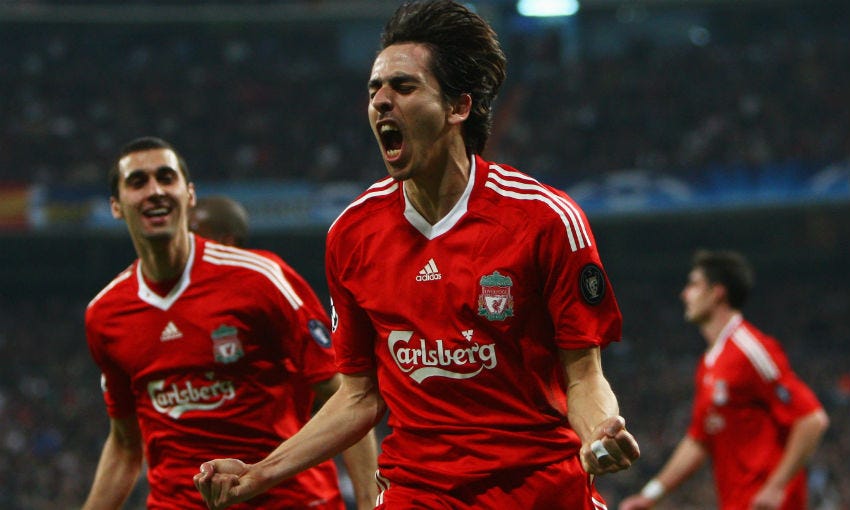
A player who absolutely tormented us when he lined up for West Ham United against us in the 2006 FA Cup Final, I was curious how Yossi Benayoun would fare after he took a pay cut to join Liverpool. Mostly used as a squad player and a rotation option, it resulted in Benayoun being fielded against some hilariously overmatched opposition in his debut season.
Yossi notched hat-tricks against the magnificently named non-league team Havant & Waterlooville in the FA Cup (H&W were winning at one point, YIKES), and Besiktas, who have less of an excuse, in an 8-0 win in the Champions League. He eventually retired as one of only three players to have scored Premier League, FA Cup, and Champions League hat tricks.
A diminutive playmaker capable of mazy dribbles, threading a pass or a powerful shot, Yossi Benayoun always stood out to me for his fiery demeanour on the pitch. He was the type of player who typified those Rafa-era Euro-adventurers: strong-willed, passionate players who you underestimated to your own detriment.
Lucas Leiva (2007 - 2017)
by Jordan J. Keeble @jjkeebs/@aredarrowblog
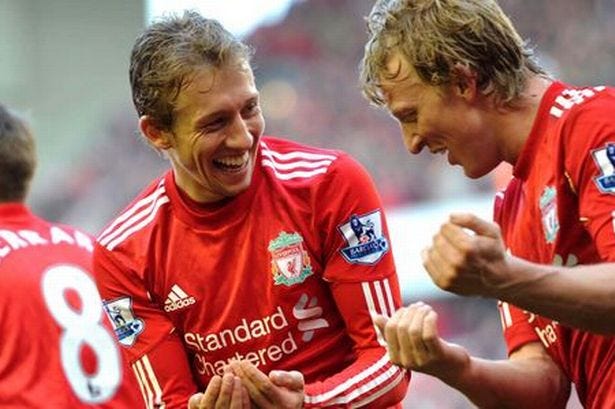
I have never kept it a secret my feelings for Jordan Henderson, but right around the same time that Hendo entered my life, so too did Lucas Leiva. I became a fan in 2010 after the World Cup that year and he was already there. He was one of the first players that I was able to cling to, to recognize and support, through his "take no shit" demeanour on the pitch.
There was also the funny thing about watching his recovery on that whole Being: Liverpool series that endeared me to him. I was still a baby fan when that stupid series came out and the parts that focused on him did not exactly hurt my burgeoning love for him. This goofy Brazilian, ready to joke and be friends with everyone on the team, even as he recovered from this awful injury, was the perfect entry point for me. If you haven't seen the video of him and Hendo playing carnival games, you should. Or really any video that he does with Hendo.
Though, my best Lucas story comes from my first trip to Liverpool. I was there for Steven Gerrard's last game at Anfield with a couple of friends, and we found ourselves in the massive Liverpool One mall, waiting outside a beauty store. Three men walked near us, the middle one texting. I remarked to my friend that he looked like Lucas, and as if in slow motion he looked up. It was Lucas. She chased him down to talk to him, tell him that we came from California for Stevie's last games and the Player's Awards that were that night. As she was talking to him, I got overwhelmed with my feelings of love and how much he meant to me, and just as they turned towards me, my eyes welled up and I ran away to hide. She came back and calmed me down after, fairly, making fun of me for crying and running away from Lucas Leiva, and convinced me to chase him down and talk to him myself. When I finally did, he was very sweet and gracious with his time and didn't say anything about watching this poor American girl start to cry around him.
It wasn't until 2017 when my (now) boyfriend and I went back to the city for the last game of the season and we found ourselves at Lucas' last game as a Red, joining in the crowd yelling SHOOT every time he touched the ball. Everything had come full circle for me as a Lucas Leiva fan.
I still regret not getting a picture in 2015, though.
Raul Meireles (2010 - 2011)
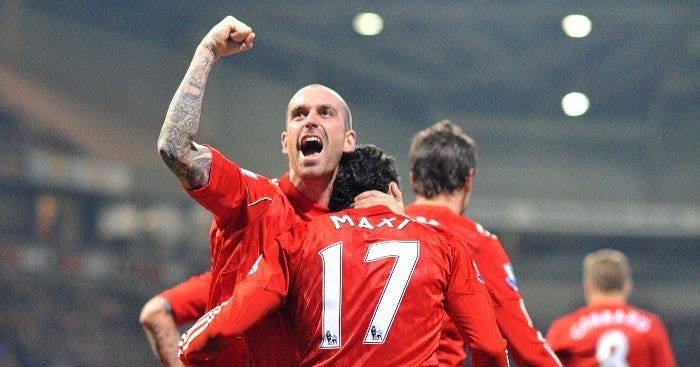
The last of the Liverpool to Chelsea exodus gang presents us with a strange player for the strangest time in Liverpool’s history. Raul Meireles’ lone season at Anfield was the most captivating thing in that weird Hodgson-Dalglish season. Signed after impressing at the 2010 World Cup for Portugal, Meireles was brought in alongside other legendary names in Liverpool history such as Christian Poulson, Paul Konchesky, and Milan Jovanovic.
We call this period (credit to @aj_joven) the Hodgepocalypse. By the time of his sacking on 8 January 2011, Hodgson’s “fuck it” approach to management had left the Reds 12th in the table, with more defeats than victories from their first 20 Premier League fixtures. Things weren’t better on the cup side of things: Liverpool were also knocked out of the League Cup at the first possible opportunity after losing at home to League Two Northampton Town, as well as being booted from the FA Cup at the first possible opportunity after losing to Manchester United at Old Trafford. It was fucking dire.
Things took a stranger turn when Kenny Dalglish was appointed manager. Raul Meireles suddenly couldn’t stop scoring. Unleashed in a central attacking position, the Portuguese midfielder chimed in with goals against Everton, Wolves, Stoke, Chelsea (against Torres in his first appearance for Chelsea), and Wigan. He would win the PFA Fans’ Player of the month award for February. The goals eventually dried up, with Meireles never scoring again after that 1-1 draw with Wigan. However, Raul Meireles was still voted the PFA Fans’ Player of the Year. Not just for Liverpool. But the WHOLE league. With a record of 5 goals in 33 appearances. The quirk of the format was that fans could only vote for players who had won the monthly award, meaning it was a rather limited pool of players to choose from. But still. When I think of Woy Hodgson’s depressing time at LFC, I can’t help but think of that one month Raul Meireles was, against all odds, the best player on the planet. What a strange time it was.

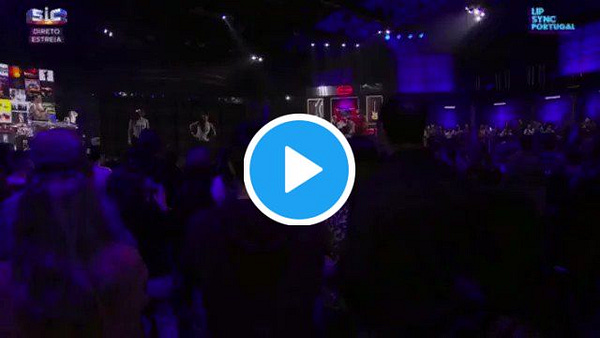
By the way, this is Raul Meireles in 2019, on a local Turkish version of Lip Sync Battle.
Maxi Rodríguez (2010 - 2012)
by @mattiecamp
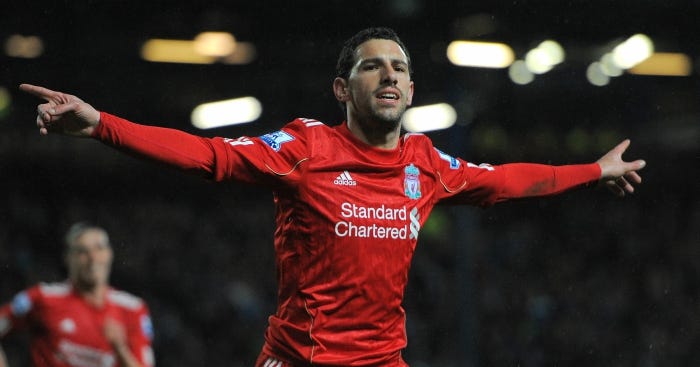
It's 21st November 2011, 3:33 am in Sydney, Australia. 17,000km away in London, a man in a red shirt with the number 11 and the name "Maxi" on the back has just slotted Liverpool's opening goal away to Chelsea at Stamford Bridge. Our bar erupts with cheers; there are a dozen-plus a handful of us from the local supporters’ group who have gathered to watch the match. A chorus of the famous refrain rings out - Maxi, Maxi Rodríguez, runs down the wing for me - once, twice, ten times, twenty. It goes until and through halftime, our voices becoming hoarse and our pints neglected.
Maxi Rodríguez's 30 months on Merseyside covered the most tumultuous period in our recent history; signed by Rafael Benitez, Rafa's departure, Hodgson's months, Hicks and Gillette meltdown, Fenway's arrival, the return of King Kenny, and the League Cup triumph. By the time he returned to his native Argentina, he had played in 73 matches for Liverpool FC, and scored 17 goals and assisted 6 more. But oh what goals they were; hat tricks, arriving runs, brilliant angles, and unbridled joy from fans on the other side of the world. Maxi may not have a statue or the accolades of some "legends", but for those of us who experienced the darkest of days in the smallest of hours, Maxi will always run down the wing for us.
Suso (2012 - 2015)
by @aj_joven
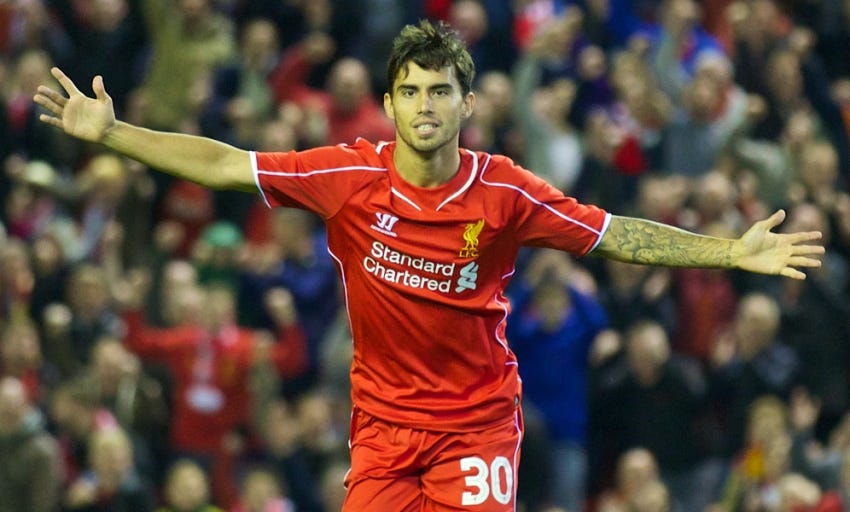
It's more than just the hair, of course. But, like, you have to start there. Impossibly well-coiffed. Carrying the impossible mix of bounce and hold. It was pretty perfect.
It'd stop at the hair if the young kid couldn't play but, man, the guy had a rocket on him. And while he wasn't exactly a burner - nor was he physically imposing - the guy seemed to have a bit of mean streak in him; there was a bite in his tackles that that belied his frame.
Suso also carried with him the hefty burden of being an academy product to finally come good after a rather dry period of seeing youth matriculate into the first team. There were a few who had some solid outings but eventually would show themselves to be wanting. And given that he was an attacking player, and the team was in need of a magician, it made the possibilities that much easier to root for.
The story obviously ends with him not quite making the grade here. Which is fine. But he did find a place with AC Milan. And of the young ones who'd been trained at Melwood, he and Conor Coady stand apart in terms of solid careers in the present.
Suso never would make sense for what Liverpool would eventually become, but I sometimes still think of that laser off the uprights against Stoke and allow myself, for a minute, to believe it may have been. I could survive for some time on the warmth of that nostalgia. Carry on, little prince.
Philippe Coutinho (2013 - 2018)
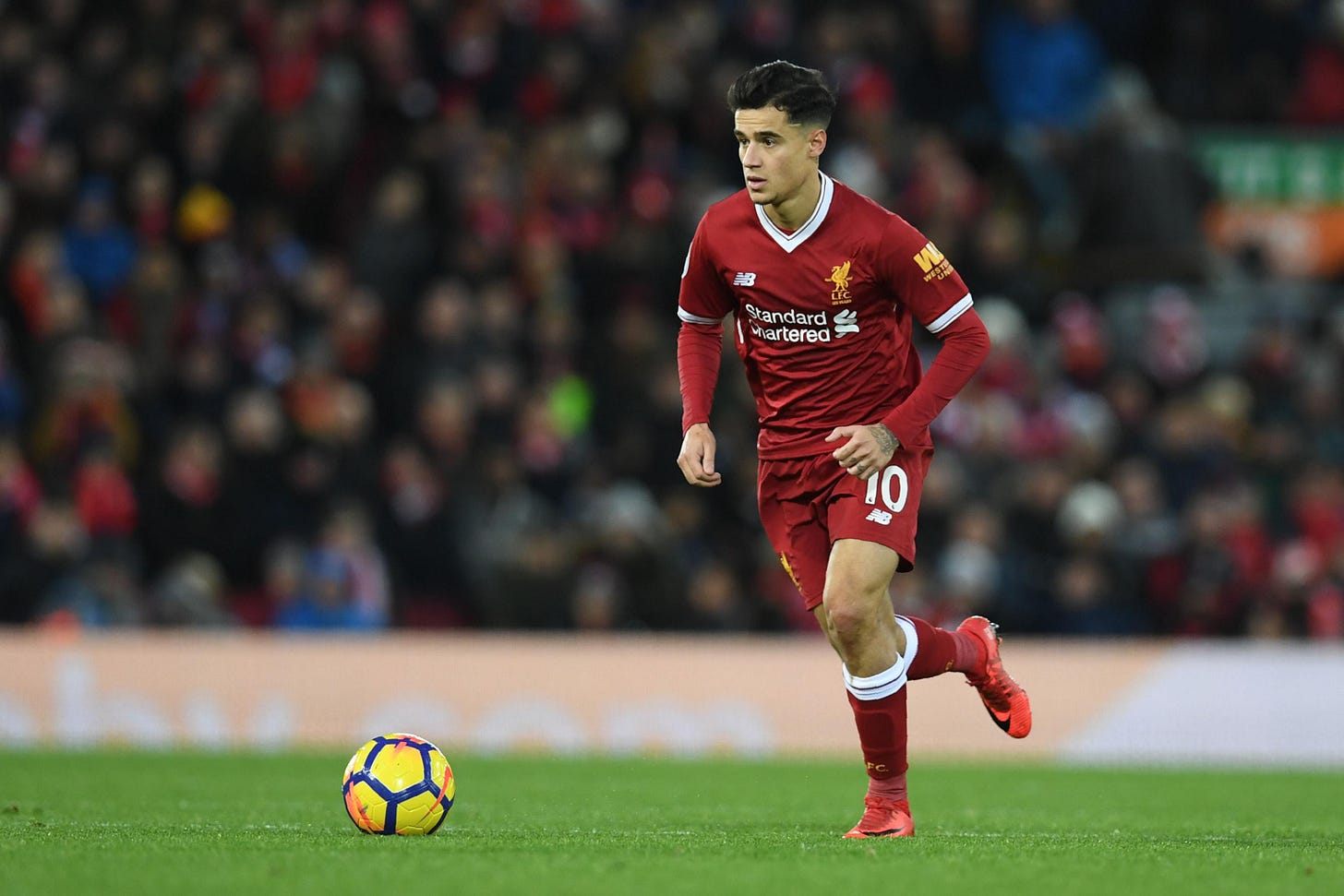
Full admission: I’ve always been a fan of Brazilians. Ronaldo was my favourite player growing up. So anytime Liverpool signs a Brazilian player, I get excited. Coutinho’s emergence as a player would coincide with the unexpected title challenge of Brendan Rodgers’ 13/14 team. That team that had run the winners so close practically disappeared almost overnight. Luis Suarez would leave for Barcelona after chewing into Chielini’s shoulder at the World Cup. Steven Gerrard’s physical decline finally caught up with him, and he would leave the club at the end of the 14/15 season. Daniel Sturridge would begin a string of injuries that would rob him of his dynamism upfront. Ill-suited reinforcements like Rickie Lambert, Fabio Borini, and Mario Balotelli would mean that the bulk of the team’s creative responsibilities would fall to two young contributors from that team: Raheem Sterling and Coutinho, both of whom would end up forcing their way out of Liverpool. Both of them cut miserable figures as a creative malaise fell over the team. With the other striking options not producing, Brendan Rodgers asked Sterling to play as a false nine. He would force a move to Manchester City later that summer. In the meantime, bereft of pace and attacking options in front of him, Coutinho fell in love with his shot and bad habits, forcing potshot after potshot from outside the box.
A short period of time later, Rodgers was out and Klopp was in. Under the tutelage of the German, Coutinho’s all-around game improved… to the point that the Brazilian team, which had previously ignored him, started making him a regular fixture of their team. Tite even reportedly called Klopp for tips on how best to utilise the Magician. The long shots were… reduced somewhat. Able to play and shoot effectively with both feet, Klopp deployed Coutinho in a free role on the left side of the attack, giving him free licence to dribble, shoot, or pass as he saw fit. And as the attacking talent improved, so did his production. First, it was Firmino. Then Mané. Then last piece of the attacking puzzle, Salah. But it was too late. Months of rumours linking him with Barcelona had finally turned his head. When the rumours first emerged, I thought surely he’d understand that this coach and club had unlocked the very best form he’s ever been in? Surely he’d understand the gigantic leaps the club was making every season? Even if his good friend Neymar had already gone to Paris, he seemed to have his heart set on moving to Catalunya. Faked back injury and half a season later, Coutinho packed his backs and left.
After his struggles at a turmoil-filled Barcelona and Bayern Munich, it’s pretty hard for me to still hate the guy. In letting Coutinho go, it was almost as if Liverpool were breaking out of their cocoon. They were ready. The team didn’t need that protective coating, the insurance plan anymore. In his absence, Liverpool got Virgil Van Dijk and Alisson Becker, two practical signings who fixed the team’s defensive issues for good. The creative onus fell to our prodigal fullbacks Trent Alexander-Arnold and Andrew Robertson and in turn, the midfield moved to shield our fullbacks… something Coutinho would be ill-suited to do. In hindsight, it all looks so natural, like things fell into place. Liverpool’s success after Coutinho makes it way easier for me to forgive the guy. I’ll remember the long range-bombs, the free-kicks, the slick dribbling, and the perfect passes. The dribble and dink against Manchester United. That telepathic connection with Sturridge and later, Firmino.
The Little Magician supplied magic dust for Liverpool during a period when they desperately needed it… and when the club outgrew its need, the team simply cancelled its magic dust subscription and deleted the dealer’s contact from the phone directory.
Daniel Sturridge (2013 - 2019)
by @aj_joven
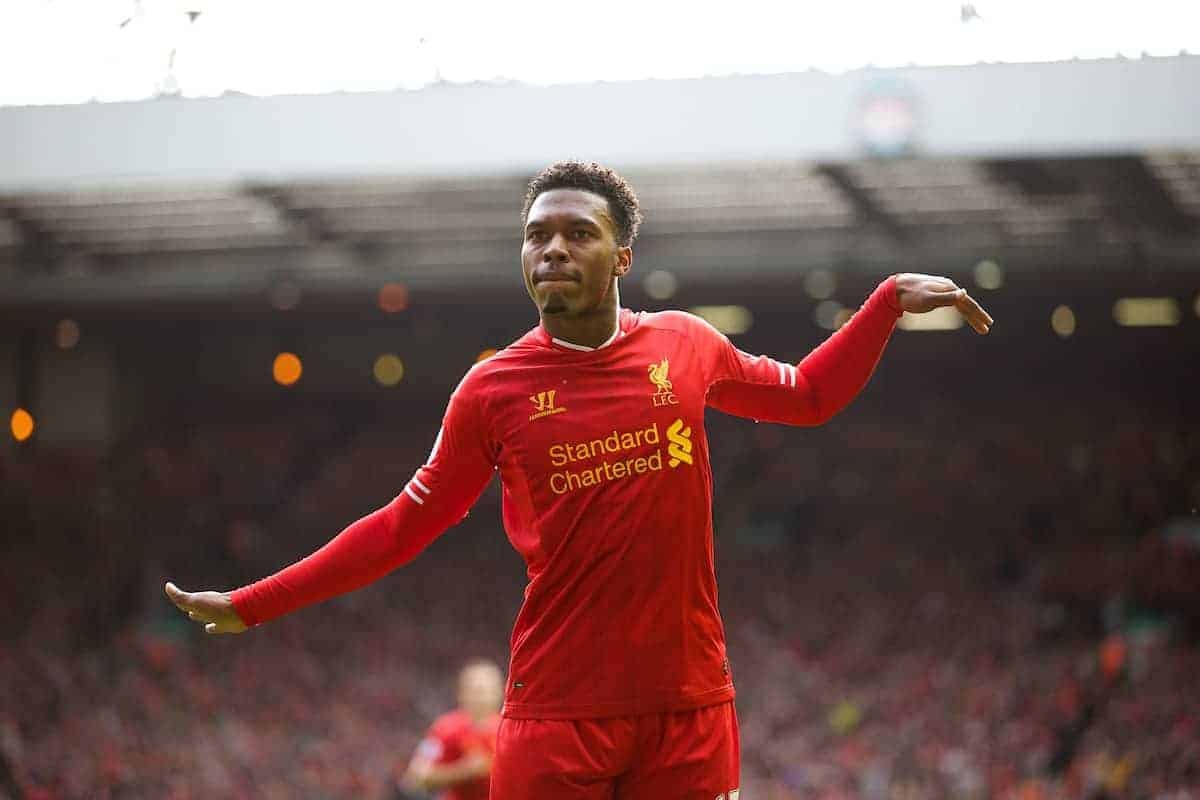
I've spent lots of time trying to weave into real, tangible language exactly what Daniel Sturridge has meant to me. And yet, even after something like 4 billion words - a conservative estimate - I know I still haven't quite got it right. So, what's another couple hundred trying to fully capture my player of the decade and, for me, the one I feel most bittersweet for at this moment.
And perhaps the easiest way to explain that is to go back to the last time Liverpool had come this close to the mountaintop: 2013-2014. It was Sturridge's first full season with the Reds after signing during the 2013 Winter Window. That season was wildly glorious and even though it may have been defined by Liverpool failing, again, to do the job, I'll always remember it was the year that Daniel Sturridge lay claim to being the best English striker.
The personal glory is fine, of course. But where people might point out that Sturridge would never again light up the score sheet in that same way again - injuries robbing him of the athletic gifts that complimented his sublime technique and touch - I point out how he managed to serve the club and the fandom in ways that went beyond the goals.
I think a lot about how he danced with fans, wrapped his arms around young Black players, and how he never pouted or spoke ill of the club. He was, in a word, a model player.
There was joy for me seeing him on the team bus during last year's Champions League celebration through Liverpool. He'd turned his Winner's Kit into a bandana and just seemed to revel in this victory lap. It was the absolute least that he deserved; getting to see European glory after a race well-run.
If I had my druthers, he'd have still been with us for this year and had the chance to celebrate Liverpool breaking their duck. But, then, his story was never one rooted in easy narratives. Which is funny, given how effortless his play was.
It's all to say, I guess, that it had to end this way. But there's a part of me that wants to believe that, on that podium, the Spirit of Studge gave his patented dance. He didn't get Hollywood endings, but I can't think of another player who deserved one more.
Kolo Touré (2013 - 2016)
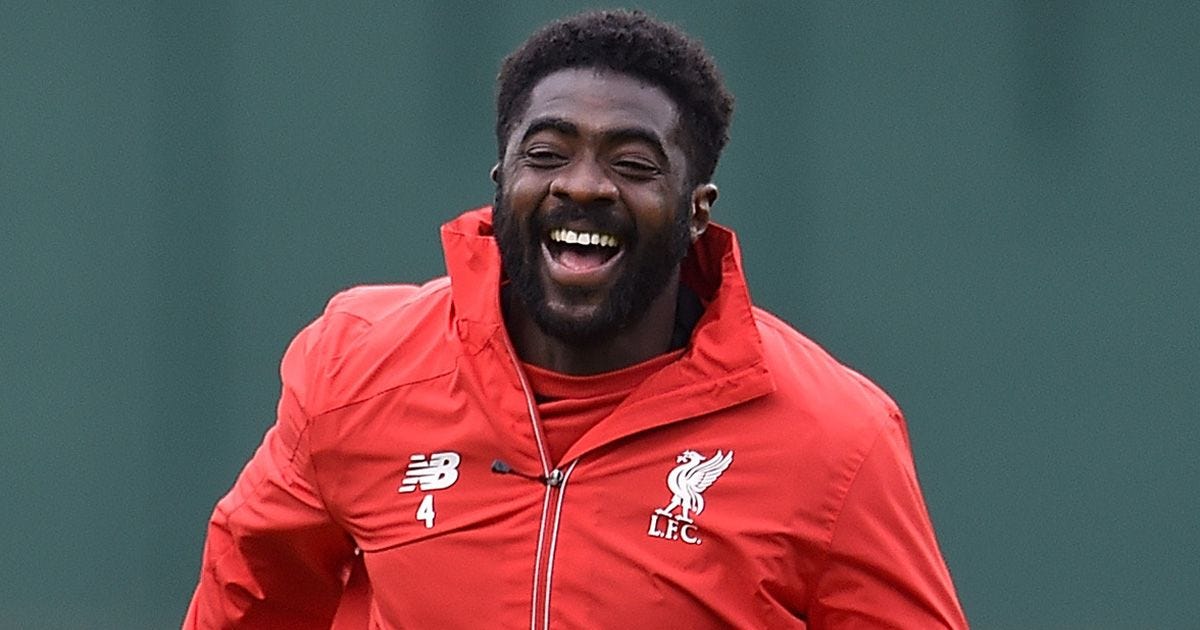
By the time Kolo Touré had made his way to Liverpool on a free transfer, he was way past his Invincible best. He wasn’t asked to provide much beyond the occasional game and to provide that much-needed VETERAN LEADERSHIP in the locker room. Just like Spinal Tap bassist Derek Smalls, Kolo was that stream of lukewarm water in the team.
But provide for us, he did. There were the always uplifting memes.

There was the time he ran through a referee, for no real reason other than our presumed entertainment.
Remember when he scored his only goal for Liverpool and celebrated with pure unadulterated happiness?
And finally, this. Look at Gerrard move.
Alberto Moreno (2014 - 2019)
by @aj_joven
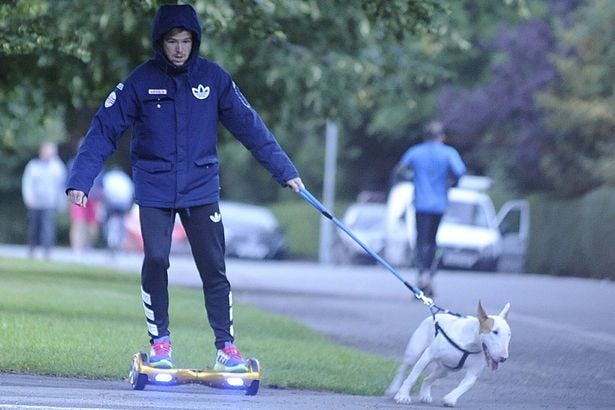
There's a deep cut of a joke in *Flight of the Conchords* that essentially is a play on old kid's claymation shows from the 80's. It's called Albi the Racist Dragon and comes with a pretty terrific theme song.
I bring this up not because Alberto Moreno is racist - though, I guess it is always a good time to remember that our heroes are humans who will inevitably disappoint us, so there's still time! - but because the enduring thing I'll remember about him is his sweet, good-natured demeanour. The guy was a pretty good left-back who, a year before his departure, managed to temporarily displace Andrew Robertson.
Which is funny because a lot of the Moreno narrative swirled around a guy who had decent athletic gifts but who was just too inconsistent. I don't think that the inconsistency issue is false, but for about 8 weeks in the winter of 2018, it looked like he'd managed to finally put it all together.
Of course, we know that Robbo would become part of the most creative and devastating fullback pairings in all of football. But I'll always think back to that run of games for Moreno and smile and hum that goofy song.
*Dex: Alberto Moreno also blocked our good friend @Saint_Grobian for reasons unknown to most of us. Lad.
Ragnar Klavan (2016 - 2018)

With the departure of Kolo Touré, there was a need for a new backup centreback and meme lord. Enter Ragnar Klavan.
There were the outrageous displays skills. The movie poster memes. Liverpool FC’s history is full of players, who for the strangest reasons, get latched onto by the fans. For whatever reason, Ragnar Klavan’s story really resonated with the supporters. The Estonian captain understood from the start that he wasn’t going to play much. And when he was thrust into action more often than needed, he just seemed to have a blast of it all, and never took things too seriously. All hail the meme lord.
Honourable Mentions:
The wobbly heroics of Jerzy Dudek.
Hardman Dietmar Hamann.
The brilliance of Luis Suarez when he wasn’t being racist or cosplaying as Hannibal.
Pepe Reina’s safe hands and penalty saves.
CM4 legend Neil Mellor.
Welsh Xavi Joe Allen.
The class of Jari Litmanen.
Emre Can’s hair.
Djibril Cisse’s hair, DJ skills, and injury return.
Craig Bellamy’s insanity.
Andriy Voronin’s ponytail.
Steve Finnan’s consistency.
Mauricio Pellegrino’s actual speed, which seemed like slow-motion when it was in fact in real-time.
Martin Skrtel’s penalty box grappling.
Vladimir Smicer’s last appearance.
Markus Babbel’s free transfer value.
Peter Crouch’s height and robot dancing.
THIS Aly Cissokho skills compilation.




